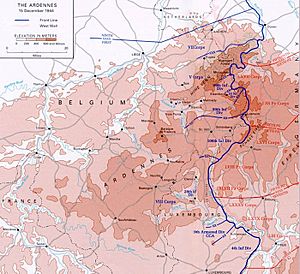Salients, re-entrants and pockets facts for kids
A salient is a part of a battlefield that sticks out into enemy territory. Imagine a bulge in a line of troops. This bulge is surrounded by the enemy on three sides. This makes the troops inside the salient easy targets for attack. The enemy's line facing a salient is called a re-entrant, which looks like an angle pointing inwards.
If a salient sticks out too far, it can be "pinched out." This means the enemy attacks the narrow base of the bulge. If they succeed, the troops inside the salient become completely surrounded. This happened during the Battle of the Bulge in World War II.
In fortifications, which are defensive structures like castles or forts, a salient is a part of the defense that sticks outward.
Contents
Famous Salient Examples
Throughout history, salients have played a big role in many important battles. Here are some examples:
American Civil War Salients
- At the Battle of Gettysburg, during the American Civil War, Union General Daniel Sickles moved his troops forward without orders. This created a salient that was almost cut off by the Confederates. Sickles' troops were badly hurt and had to be saved by other units. He had a similar problem in another battle two months earlier.
- During the Battle of Spotsylvania, Confederate soldiers built strong trenches. Part of their trench line bulged forward to protect high ground. This curve was called the Mule Shoe Salient. Union troops attacked this point very hard. After 22 hours of intense fighting, they broke through. The Confederates then moved back to a new position.
World War I Salients
- In World War I, the British army held a large salient near Ypres for most of the war. This area was created after the First Battle of Ypres. It became one of the bloodiest places on the Western Front. When British soldiers talked about "The Salient," everyone knew they meant Ypres.
- A similar salient existed around the French city of Verdun. The Battle of Verdun fought around this salient caused huge losses for both sides.
- Also in World War I, the Germans held a small salient near Fromelles. It was named the Sugarloaf because of its unique shape.
World War II Salients
- In World War II, the Soviet Union held a massive salient near Kursk. It was about 150 kilometers (93 miles) deep. This area became the site of the largest tank battle in history. It was a very important battle on the Eastern Front.
- Also in World War II, the German Army launched a surprise attack against Allied forces in the Ardennes. This attack created a large bulge in the Allied lines. It is famously known as the Battle of the Bulge.


